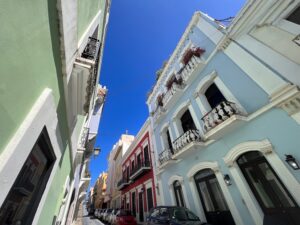
We had a big day ahead of us on our fifth day, an excursion to San Juan, Puerto Rico’s largest city. In order to maximize our time there, we woke up in Jayuya at 7am to the cacophony of all the rooster songs, enjoyed our early morning swim in the pool (well, Amy and I did), had our coffees, and quickly we were off.
We decided to focus our attention for the day on Viejo San Juan (Old San Juan), which is a historic section of town located on a tiny island to the northwest of the main city, connected to the rest of the city by bridges. All around town you’ll notice banners marking 500 años de la ciudad, as from September 2021 to June 2022, the city is celebrating its quincentenary, the city christened San Juan Bautista de Puerto Rico in 1521. (European invaders began murdering the Taíno several decades before this, of course.)
As usual, the drive to a larger city involved navigating the comically narrow and hilariously steep mountainside roads that continued to provide stunning views of Puerto Rico’s densely forested mountains. And, as usual, as we approached San Juan, the roads became wider and wider and faster and faster while still providing those incredible vistas. In previous posts, I’ve gushed and gushed about how exciting it is to drive in Puerto Rico, and that sentiment still hasn’t changed. That said, those of us who are less adventurous (more sensible?) might find these roads quite terrifying, indeed.
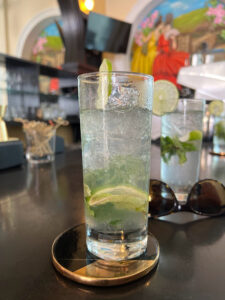
Arriving in San Juan, we parked our car in un estacionamiento on a street called Paseo Covadonga for $5 and began nuestro caminar en la ciudad vieja. What’s immediately and strikingly apparent as you walk through the narrow streets of Viejo San Juan is that this clearly is a city built by Europeans, and it wouldn’t look out of place in any Spanish city, a mixture of Gothic, Baroque, Renaissance, and Neoclassical designs, complete with building facades painted in exuberant pastels and adorned with ornate wrought iron balconies and window trimmings along with tall, majestic, heavy, wooden doors. Indeed, I was reminded of the architecture of glorious New Orleans as we walked the narrow cobblestone streets flanked by buildings exploding with color and exuding charm from an era that will never go out of style.
We first were feeling a little thirsty, so we stumbled across a smart little place called La Mallorquina (“The Majorcan,” or a lady who comes from the island of Majorca in the Mediterranean). We didn’t know it at the time, but it’s possible that this restaurant is the first food establishment on this island, opened in 1848, and run by the same family, the Rojos, since 1900. It’s adorned with floors of classy, white-and-black square titles, walls of bold yellow and elegant white, terra cotta roofs, and grand archways. The service was equally posh, our camarera mixing up mojitos right in front of us, muddling the mint with sophisticated finesse.
Following our drinks, we made our way to lunch at a restaurant called La Casita de Rones (“Little House of Rums”), located right on the southern waterfront. The restaurant is painted brightly in pink, and it offers what could be stunning views of Vajo de Manglar (this seems to translate to Mangrove Swamp, but I’m not entirely sure), the small bay on the south side of Viejo San Juan. However, hideously tall cruise ships obscured the views as the monstrosities brought frustratingly loud tourists from the United States who only spoke English to mute the delicately light and enchantingly seductive lilts of all the Spanish speakers.
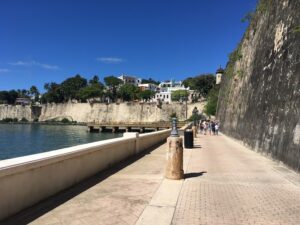
Regardless, our dining experience at La Casita de Rones was delightful indeed! As I wrote about in my previous posts, in the larger cities the locals seem to default to English even when you speak in Spanish. But it’s still so much fun trying out whatever you’ve learned (and I continue to highly recommend that—at the very least—you learn the very basics I posted about in dia uno, but I’ll probably judge you if you don’t learn more). For example, there was one drink I wanted to try called a Rum Message (Bacardí superior, cocchi americano, pamplemousse liqueur, agave real, fresh citrus juices, grapefruit sour juice & Angostura bitters), and I ordered it as, “Quiero un mensaje de ron,” just to see what our camarero guapo (and, oh my goodness, was he handsome) would say. He had a really good laugh with me, and then proceeded to tell me I could order it by pronouncing it as, “Rone me-SAH-hay,” but he still understood what I meant. Amy and Aaron, meanwhile, tried a Sexy Colada and a Jail Monkey, both drinks essentially a variation on the traditional piña colada.
Following drinks, I enjoyed some delectably tasty tacos de pescado (with mahi-mahi) while Amy and Aaron enjoyed stuffed mamposteao (stewed local beans, sauteed vegetables, white rice, with your choice of protein) and something else that I’m forgetting. As we finished up lunch with another round of drinks, I flagged down nuestro camarero guapo and asked, “¿Tenemos la cuenta, por favor?” I messed up a little bit, as this translates to, “Do we have our check, please?” It would have been better to say, “¿Podemos tener la cuenta, por favor?” or, “Can we have our check, please?” However, the handsome, handsome hombre knew exactly what I meant, and I think he might’ve been impressed that I knew how to conjugate tener at all or knew what a cuenta was.
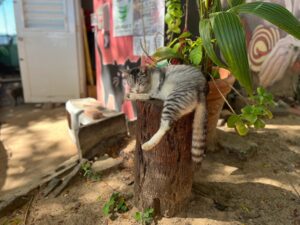
I made one final error as we were leaving La Casita de Rones, wishing our waiter, “¡Disfruta el dio!” which is, “Enjoy god!” (I’m so sorry) when I meant to say, “¡Disfruta el día!” which is, “Enjoy your day!” Regardless, I still think he understood what I meant, didn’t presume we were missionaries, and was impressed I knew the verb disfrutar at all. He seemed so appreciative of our visit he pressed his hands together at his chest, smiled, and wished us well. I honestly don’t think we would’ve received such a happy farewell had we spoken no Spanish at all.
Next we decided to make our way to Castillo San Felipe del Morro, a 16th century Spanish fortress built on the most northwestern tip of Viejo San Juan. The walk was a leisurely 30 minute promenade as we traced the waterfront using Paseo del Morro, a pedestrian walkway that provides incredible views not only of la Bahía de San Juan, but also the centuries-old Spanish walls that rise several meters from the rocky shoreline and are several feet wide as to protect the city from oncoming attacks.
We enjoyed several other sites as we made our way to the castle: a little outdoor market on Paseo de la Princesa (an elegant stone walkway embellished with tall, stately lamp posts and knobby, craggy trees that provided ample shade in the heat and humidity of Viejo San Juan); Fuente Raíces (“Fountain of Roots,” as it were; an elegant fountain of horses, dolphins, and gods and goddesses of Taíno, European, and African cultures to celebrate the people of Puerto Rico); and Puerta de San Juan (a centuries-old gate of two large, heavy, wooden doors standing several feet tall, the archway painted brightly in red, the last of six gates that survive to this day that allows foot traffic through the imposing Spanish walls).
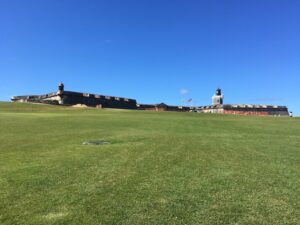
We also discovered a lovely, little, modest, pink building with a giant mural of a sphynx cat with striking blue eyes that housed Save a Gato, a non-profit organization created to address the cat overpopulation of Viejo San Juan. Their website states: “SAG is the only non-profit organization that has an agreement with The National Park Service to manage a colony of cats on national park land.” Their work to trap, neuter, and return cats has helped to reduce the cat population in Viejo San Juan by 50% since 2004. They also help foster and adopt cats, and they stress that they are not a shelter. So please don’t just dump your cats off at their building or the nearby Parque de los Gatos.
Many of the cats you’ll encounter on your walk along the waterfront (indeed, around all of Viejo San Juan) are healthy and friendly. But there are many others who are very shy and wary of humans and more still who are visibly ill, malnourished, or injured. While it was heartwarming to encounter the organization to help all the cats of San Juan as best they can, it was also quite sad to encounter other cats who were having a tougher time than the others. Regardless, the work of Save a Gato is obviously so important, so I encourage you to follow them on Facebook and Instagram and—if you can—donate money to them as well.
After saying hello to, visiting with, and petting several cats, we at last made our final approach to Castillo San Felipe del Morro (named after King Phillip II of Spain and called El Morro for short), which sits atop a hill, a sprawling greenspace inviting us to continue the climb to the castle. Constructed from 1539 to 1790, the Discover Puerto Rico website writes: “[The] fortress has seen many battles over the centuries, from Sir Francis Drake’s attack in 1595 to the 1898 bombardment of San Juan by the US Navy, but it has never been defeated.” The fortress came under U.S. control following the conclusion of the Spanish-American War in 1898 and was used as a military installation in the two world wars before it was retired and passed to the National Park Service when it became a museum in 1961.
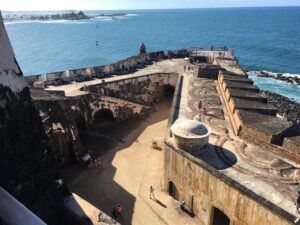
In contrast to castles like the Tower of London or Culzean Castle in Scotland, El Morro isn’t outfitted with opulent dining rooms or extravagant bed chambers. Rather, it is a mostly abandoned—yet intact—fortress standing imposingly tall, its limestone and sandstone walls stained shades of grey due to the ravages of time. Visitors walk through the wide open structure to learn about the history of the castillo (you can elect to do a self-guided audio tour, if you want), view artifacts like original canons in their batteries, and enjoy views of the sea from the fortress’s commanding outer wall, the sea breeze providing a refreshing respite from the relative heat and humidity.
Following our visit to the castillo, we made our way to the nearby Cementerio Santa Maria Magdelena de Pazzi. It’s a relatively new cemetery in the grand scheme of things, dating back to 1863, and it’s entrance is guarded by a grand, gated archway painted white and gold. The cemetery closes at 3pm every day, so we didn’t get to walk inside. However, through the gates and from atop the hill as we headed east towards our next destination, we were still able to view the extravagant above-ground tombs and grandiose memorials constructed in elegant marble.
Very near to the cemetery is a street called Calle Norzagaray, where we viewed some colorful street art: black and brown fists raised to the sky, one holding an LGBTQ pride flag and another a sign that declared in all caps, “NUESTRA TIERRA NO SE VENDE,” or “Our land is not for sale.” There were other parts of the street inscribed with the message, “Gringo leave or you will never know peace.” The emotions of the art were raw, and it highlighted the complex relationship between the U.S. and Puerto Rico. I’ll be writing more about this for my post for día seis when we went to a coffee plantation museum and día diez when we had an enlightening and spirited chat with a bartender, so if at the moment it feels like I’m short-changing the value of this topic, please come back for my later posts.
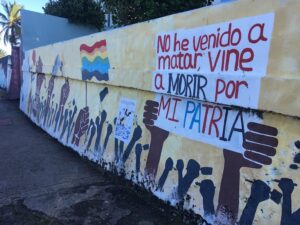
Our next destination was Museo Casa Blanca—originally built in 1521 as the main residence for San Juan’s first governor, Juan Ponce de León—but that, too, had closed by the time we arrived, so we were only able to view it from a distance through the locked, wrought iron gates. We instead happened to stumble across the nearby Catedral Basilica Menor de San Juan Bautista, the oldest cathedral on U.S. soil and the second oldest cathedral in the Americas (the oldest being Cathedral of Santa María la Menor in the Dominican Republic).
I do love viewing old churches even though I’ve long since stopped practicing any such religious activity over two decades ago. The cathedral is relatively modest in size when compared to, say, Westminster Abbey in London or Saint Patrick’s Cathedral in New York City, but that doesn’t distract from the age and history of this cathedral. Its facade is humble—a no-frills neoclassical design of unassuming arches and simple pillars painted in shades of creams and whites. On the inside, the neoclassic design continues with the same color palette except with additional golden ornamentations painted in the arches and domes, and the floor is tiled with large black and white squares angled like diamonds. There are also several chapels to view on the inside as well as the burial site of Juan Ponce de León himself.
Our walk through the streets of San Juan continued as we tried to find a hotel that has most likely long since disappeared, Old San Juan Hotel, on the suggestion of our friend Carol who had been to San Juan some years ago and who recommended we check it out. While we aren’t entirely positive we actually found the building that originally housed the establishment, we still got to enjoy more of San Juan’s beautiful old world architecture in addition to a tiny little stone chapel called Capilla del Santo Cristo de la Salud, built between 1753 and 1780. It’s a one-room chapel open to the air, protected only by wrought iron gates. It was built on the site of a miracle (apparently) where a man called Baltazar Montanez lost control of his horse, both plunging over the cliff face. Spanish Secretary of Government Don Mateo Pratts witnessed this and cried out, “Christ of Good Health, save him!” I’m not sure why he didn’t ask his god to save both lives, as the prayer was answered quite literally: the horse perished and the man didn’t.
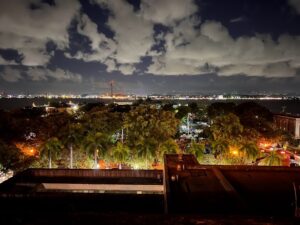
The sun was beginning to set, so we decided to enjoy some cocktails before our dinner. Near the chapel we found a bar/restaurant called Tetuan Old San Juan (stylized as T•tuan), and while the drinks were enjoyably fruity, it was at this point where we started to notice that lots of cocktails in Puerto Rico tended towards the sugary side of the spectrum (which is fun), but also a tad bit much, even for this sweet tooth who’s known to eat three slices of cake in one sitting. That said, it’s still been incredibly enjoyable trying out rum cocktails made with guava and passion fruit, which is perfect for a long day walking around an old city baked in the tropical sun.
We last made our way outside of Viejo San Juan to a restaurant called La Casita Blanca, for a dinner of authentic Puerto Rican food. I highly recommend exploring San Jaun outside the touristy hub of Viejo San Juan, as the contrast in the neighborhoods couldn’t have been more apparent: the buildings were less manicured and less colorful (this isn’t a bad thing) and Spanish dominated as we passed by others on the streets.
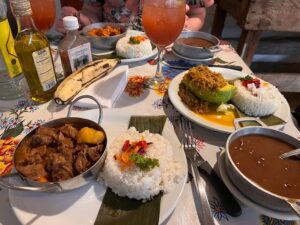
The restaurant itself was invitingly friendly, relaxed, and casual. Menus were brought to us on large chalkboards propped up by our table. We had to get out our phones to translate some of the dishes, but that’s part of the fun. Also make sure to only order what you see on the menu, as I asked for a mojito (which wasn’t on the menu), and the waiter badgered me that I can have a mojito if I sing a song! So, we all opted for what was on the menu: sangrias. For our meals, we all enjoyed various stewed meats with beans and rice, but I was particularly envious of Aaron’s dish where the meat was stuffed in a lusciously giant avocado. Seriously, the avocados here are so, so huge—larger than most people’s fists.
As we ruminated over our day’s adventures, it became apparent that we loved San Juan more than we had initially envisioned we would. We had very deliberately chosen to stay in Jayuya, a remote part of the island tucked away in the mountains away from all the loud tourists, but San Juan captured our hearts so immediately and so thoroughly and so powerfully that we knew we had to come back again and again and again.
Before that was to happen, however, we had planned for our following day to be much more quiet as we decided to remain in the sleepy mountains of Jayuya…
Spanish lesson for the day:
- The Duolingo app will teach you that the word for orange (the fruit) is una naranja. However, in Puerto Rico, they seem to call the fruit una china.
- Continuing on the food theme, you’ll want to know that beer is cerveza and wine is vino. If you want white wine you’ll request, “Quiero un vino blanco,” while red wine would be, “Quiero un vino tinto.” Tinto can be translated as dyed or stained (in addition to red), but if you want to refer to the color red on its own, you’d say rojo. But you’d never refer to red wine as vino rojo.
- To say you’re hungry, you’ll say, “Tengo hambre,” which translates literally as, “I have hunger.” If you are thirsty, you’ll say, “Tengo sed.” If you want to speak for the group to say, “We’re hungry,” you’ll say, “Tenemos hambre,” and “Tenemos sed.”
- Lastly, the meals (breakfast, lunch, dinner) are desayuno, almuerzo, y ceda. It’s actually handy to know these words because some food establishments may only serve desayuno y almuerzo pero no ceda.
Travel tips, day five:
- Dining out in Puerto Rico will progress at a slower pace than people who live in any U.S. state might be used to (Europeans, on the other hand, might feel like it’s still too fast). So, don’t feel like you’re inconveniencing the server (camarero/camarera) by flagging them down if you need something. Also don’t feel awkward when you have to ask for the check (“La cuenta, por favor”), as el camarero or la camarera is expecting that.
- Puerto Ricans tend to prefer to back into parking spaces that are perpendicular to the flow of traffic. In fact, sometimes parking attendants will ask that you park this way as well, so you might as well just start getting into the habit of backing into your parking spot. I’ve noticed that at grocery stores parking lots, however, people tend to park with the front of the car entering first, however.
- Lastly, while in general you’ll have one server during your dining experience, I’ve noticed that sometimes you may be in the hands of two or even three additional staff who will be able to help you as well as they bring your food or if you ask for the check.
*These photos by Amy Danielson. All others by me.

I had my espanol diccionario right by my side to read your entry. Perhaps I’ll take an espanol clase somewhere, sometime before I turn 80.
Learning a new language is so much fun! Keep your dictionary out for a few more posts!
I love your perspective and how you captured it in words. I hope you go back someday and capture more of the magic this beautiful island and “mi gente” have to offer. Thank you for sharing!
Thanks so much for following along! I can’t wait to go back, y tu gente es muy sympatico!